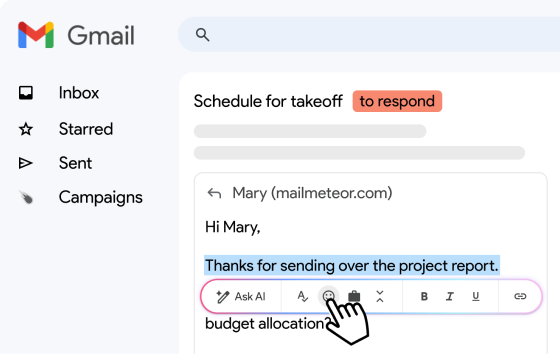We’ve all been there — finishing up an email and staring at the blank space before your name, wondering how to end it. “Best regards” is safe. Polite. Professional. But let’s be honest… it also blends in with every other email in someone’s inbox.
If you’re looking for a way to stand out — to sound human, warm, and still respectful — you’re in the right place. In this guide, we’ll break down what “Best regards” really means, when to use it (and when not to).
We’ll also share professional alternatives that feel a little more like you. Whether you want to keep things buttoned-up or add a touch of personality without going over the top, we’ve got you covered.
Here’s what you’ll learn:
- What Does “Best Regards” Mean in an Email?
- When Should You Use (or Avoid) “Best Regards”?
- Alternatives to “Best Regards”
- Best Practices for Closing Emails Professionally
- “Best Regards” Email Examples
Sounds good? Then let’s dive in.
What Does “Best Regards” Mean in an Email?
“Best regards” is a polite and professional way to end an email. It’s often used to show respect, express well wishes, and maintain a courteous tone. Especially in formal or business communication.
Think of it as a friendly sign-off that strikes the right balance between warmth and professionalism. It’s more approachable than “Sincerely,” but still more formal than casual closings like “Cheers” or “Thanks.”
In practice, “Best regards” can mean:
- I’m closing this message respectfully.
- I wish you well.
- I’m maintaining a professional tone.
It’s a go-to closing phrase for emails to clients, coworkers, hiring managers, or anyone you want to leave with a positive impression.
Whether you’re applying for a job, following up with a lead, or confirming a meeting – “Best regards” fits most situations.
When Should You Use (or Avoid) “Best Regards”?
“Best regards” is a versatile email closing. It’s professional, polite, and works in most business contexts. But that doesn’t mean it fits every situation. Here’s when to use it – and when you might want to skip it:
✅Use “Best regards” when:
- Emailing a colleague or client – It’s formal but not stiff, making it perfect for most professional conversations.
- Following up with someone you’ve spoken to before – It maintains a respectful tone while keeping the relationship warm.
- Closing a thank-you or informational message – It reinforces politeness without sounding overly enthusiastic.
- In formal introductions – When reaching out to someone for the first time, “Best regards” is a safe and respectful option.
❌ Avoid “Best regards” when:
- Your tone is casual – For friendly chats or internal team emails, something warmer like “Cheers” or “Talk soon” might feel more natural.
- You’re ending on a humorous or personal note – A playful sign-off like “Catch you later” or “Thanks a ton!” may match better.
- You want to sound more traditional – In formal letters, legal documents, or very professional settings, opt for “Respectfully” instead of “Best regards.”
- You’re in a high-stakes or sensitive situation – In legal, HR, or crisis communications, you may want to use more neutral closings like “Sincerely”.
Alternatives to “Best Regards”
While “Best regards” is a safe and professional sign-off, using it over and over can feel repetitive. Depending on the tone and context of your message, there may be better ways to close your email. Here are some popular alternatives to “Best regards,” grouped by tone and situation.
Formal Alternatives
Looking for a sign-off that’s just as professional as “Best Regards” — but a little fresher? Here are some formal and polished email closings that work well in professional settings like job applications, business correspondence, or client emails.
1. Sincerely
A timeless, formal sign-off that works in almost any professional email.
2. Kind regards
A softer, more personable variation that still maintains professionalism.
3. Warm regards
A touch warmer than “Kind regards,” ideal if you’ve already established rapport.
4. Respectfully
Shows courtesy and is particularly fitting when writing to someone in a senior position.
5. Yours truly
Formal and old-school – works best in more traditional industries.
6. Yours faithfully
Used most commonly in British English when you don’t know the recipient’s name.
7. With appreciation
Great when you want to express gratitude in a professional context.
Friendly Alternatives
Want to keep things professional, but also a bit warmer or more personal? These friendly email closings strike the right balance between casual and courteous — great for team members, clients you know well, or networking messages.
8. All the best
Upbeat and kind without being overly familiar.
9. Cheers
Casual, but still professional in many English-speaking cultures — especially in creative industries.
10. Talk soon
Ideal if you’re expecting a follow-up or ongoing conversation.
11. Take care
Simple, warm, and human — works great when you want to express genuine well-wishes.
12. Thanks again
A friendly way to show appreciation if you’ve already thanked the person earlier in the message.
13. Have a great day
A polite and positive sign-off that leaves the reader with a smile.
14. Looking forward
Great for follow-up emails or when anticipating a response.
Creative Alternatives
Looking to show more personality or stand out in a crowded inbox? These creative sign-offs are perfect when the situation allows for a little flair. Especially in less formal or internal communications.
15. Yours in caffeine
Fun, quirky, and perfect for startup or team culture emails.
16. Keep crushing it
Motivational and energetic — great for colleagues or teammates.
17. Onward and upward
Positive and aspirational, ideal when discussing progress or goals.
18. Stay awesome
Playful and encouraging, best used when you know the recipient well.
19. With rocket-speed replies
Funny and memorable — works great in fast-paced or techy environments.
20. Signed, sealed, delivered
A pop culture nod with humor, perfect for informal contexts.
Best Practices for Closing Emails Professionally
A good email sign-off does more than just wrap things up – it leaves a lasting impression. Here are a few best practices to help you close your emails like a pro (and press Send with confidence):
1. Match the Tone of the Conversation
Your closing should reflect the overall tone of your email. For formal messages, stick to polished sign-offs like “Best regards” or “Sincerely.” For more casual conversations, “Cheers” or “All the best” might feel more natural.
2. Keep It Simple and Clear
Avoid overthinking your sign-off. One or two words are usually enough – followed by your name and contact details (if needed). Overly elaborate closings can come off as forced or insincere.
3. Add Your Full Name
Especially in professional settings, it’s a good idea to include your full name at the end of the email. You can also add your job title, company name, or LinkedIn link for context – particularly in outreach emails.
4. Avoid Typos
Your email closing is the last thing someone sees – so make it count. A typo or awkward formatting here can make your email feel rushed or careless. Double-check your closing before hitting send.
“Best Regards” Email Examples
Want to see “Best regards” in action? Below are a few sample email closings you can use in different contexts – from professional to polite and slightly more formal alternatives.
1. Professional Email Example
Hi [Name],
Thanks again for your time on the call today. As discussed, I’ve attached the updated project timeline.
Let me know if you have any questions.
Best regards, [Your Name]
2. Job Application Email Example
Dear [Name],
Please find attached my application for the [Job title] position. I’m excited about the opportunity to contribute to your team.
Looking forward to your response.
Best regards, [Your Name]
3. Client Follow-Up Email Example
Hi [Name],
I wanted to follow up on the proposal I sent last week. Let me know if you have any feedback or if there’s a good time for us to discuss next steps.
Thank you for your time.
Best regards, [Your Name]
Final Thoughts
“Best regards” is a timeless and versatile email sign-off – professional, polite, and appropriate in most business contexts. But while it’s a safe default, it’s not your only option. Whether you want to keep things formal, strike a friendly tone, or show your personality, there’s a sign-off for every situation. Use the examples above to match your closing to the message, recipient, and tone. And when in doubt? You can always fall back on “Best regards.” It never goes out of style.
FAQs
Is “Best Regards” too formal?
“Best Regards” strikes a balance between professional and friendly. It’s not as stiff as “Yours faithfully,” but still more formal than “Cheers.” It works well in most business contexts, especially with people you’ve already interacted with.
Is it okay to use “Best Regards” in a reply?
Using “Best Regards” in a reply is perfectly acceptable. It maintains a respectful tone while keeping things polite and professional. Especially if the other person used a similar closing.
What’s the difference between “Kind Regards” and “Best Regards”?
“Kind Regards” is slightly more formal, while “Best Regards” is warmer. Both are acceptable in professional emails, but “Best Regards” tends to be more commonly used in ongoing business relationships.
Is “Best Regards” appropriate for a cover letter?
“Best Regards” is a safe and professional way to close a cover letter. It’s polite, neutral, and widely accepted in both corporate and creative industries. Just make sure the rest of your letter matches the same tone.
What is the best closing line for a formal email?
“Best Regards,” “Kind Regards,” and “Sincerely” are all strong options for closing formal emails. Choose based on your tone and relationship with the recipient. For highly formal settings, “Sincerely” might be more appropriate.
Can I use “Best Regards” with someone I don’t know?
“Best Regards” is one of the most versatile sign-offs and is appropriate when emailing someone for the first time. It conveys professionalism without being overly stiff.
Is ‘best regards’ outdated?
Not at all. “Best Regards” remains one of the most popular and accepted ways to end an email. While newer sign-offs like “Cheers” or “Thanks” are more casual, “Best Regards” still holds strong in formal or semi-formal contexts.
What can I say instead of kind regards?
If you want alternatives to “Kind Regards,” you can use:
- Best regards
- Warm regards
- Sincerely
- Thanks in advance
- With appreciation
- All the best



